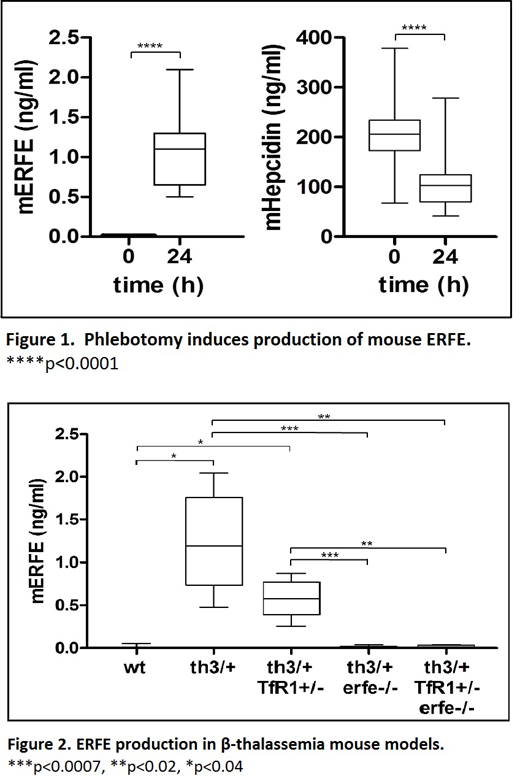Erythroferrone (ERFE) is a hormone produced by erythroblasts in response to erythropoietin. ERFE acts as a regulator of hepcidin expression during stress erythropoiesis. By suppressing hepcidin expression, ERFE contributes to the mobilization of dietary and stored iron necessary for recovery from blood loss after hemorrhage. Furthermore, overproduction of ERFE plays a pathogenic role in β-thalassemia and other anemias with ineffective erythropoiesis, where it contributes to hepcidin suppression and consequent iron overload. Development of a method to quantify serum ERFE in mice would improve our ability to study the pathobiology of this erythroid regulator.
A dual polyclonal sandwich ELISA was developed to quantify ERFE in mouse serum. Purified recombinant mouse ERFE was used to immunize rabbits and goats, and high titer antibodies were purified from serum via protein A. Western blotting of reduced ERFE protein demonstrated that both the capture and detection antibody specifically recognized mouse ERFE, weakly recognized recombinant human ERFE, but neither antibody recognized mouse, rabbit or human TNF-alpha. Antibody was biotinylated and screened to determine the optimal antibody pairs.
ELISA optimization established the standard curve range from 0 to 4 ng/ml. With a 10% sample dilution the lower limit of quantitation (LLOQ) was 0.1 ng/ml. Average spike recovery of ERFE in 3 different mouse sera (0.75 - 24 ng/ml) ranged from 93-105% (mean 99%). Dilutional linearity of the same spiked samples ranged from 93-104% (mean 99%). Intra- and inter-assay precision was 4.9% and 3.9%, respectively, over a concentration range of 0.57 - 16.3ng/ml.
The effect of phlebotomy on serum ERFE in 6- and 8-week-old male C57BL/6 mice (n=3 each) was examined 24 h after removal of 0.5 ml of blood (Figure 1). At time 0, all the mice had serum ERFE levels below the limit of detection, but serum ERFE had increased to a mean of 1.9 ng/ml at 24 hours (P=0.03). This increase in ERFE is associated with a decrease in hepcidin from 209 ng/ml to 104 ng/ml (p<0.0001).
In a mouse model of β-Thalassemia (th3/+) there was significantly greater ERFE (1.2 ng/ml, n=5) compared to wild type (wt, <0.1 ng/ml, n=3, p < 0.04). Crossing the th3/+ mice with transferrin receptor 1 (TfR1) heterozygous mice (th3/+ TfR1+/-) produced a partial rescue of ERFE (0.6 ng/ml, n=5). Erfe knockout mice (th3/+ erfe-/- and th3/+ TfR1+/- erfe-/-) produced significantly less ERFE (p<0.02) than their respective single and double mutants (<0.1 ng/ml [n=7] and <0.1 ng/ml [n=4], respectively) (Figure 2).
Collectively, this validated ELISA can quantify mouse serum ERFE in both healthy and diseased mouse models and can be used to study the pathobiology of this erythroid regulator in diseases associated with ineffective erythropoiesis.
Gutschow:Intrinsic LifeSciences: Employment, Equity Ownership. Han:Intrinsic LifeSciences: Employment, Equity Ownership. Olbina:Intrinsic LifeSciences: Employment, Equity Ownership. Westerman:Intrinsic LifeSciences: Employment, Equity Ownership. Westerman:Intrinsic LifeSciences: Employment, Equity Ownership. Ginzburg:La Jolla Pharma: Membership on an entity's Board of Directors or advisory committees. Nemeth:Silarus Therapeutics: Consultancy, Equity Ownership; Ionis Pharmaceuticals: Consultancy; Protagonist: Consultancy; La Jolla Pharma: Consultancy; Intrinsic LifeSciences: Consultancy, Equity Ownership; Keryx: Consultancy. Ganz:Intrinsic LifeSciences: Consultancy, Equity Ownership. Ostland:Intrinsic LifeSciences: Employment, Equity Ownership.
Author notes
Asterisk with author names denotes non-ASH members.


This feature is available to Subscribers Only
Sign In or Create an Account Close Modal